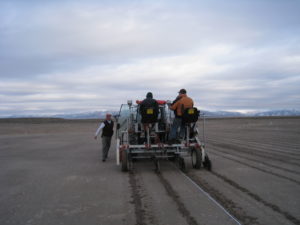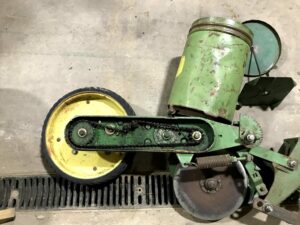Description
Grain drills use a fluted, seed-metering device, precise furrow openers, and covering devices. Furrow openers can be chisels, single disks, or double disks. Press wheels and covering devices are standard. Grain drills vary in width from 6 to 40 feet. Row spacing varies from 6 to 30 inches, with 7.5 inches widely used for cereal grains. Drills are either towed or attached to the tractor’s 3-point hitch. All towed units have hydraulic lift mechanisms. On some models, extra hoppers are available for fertilizer, pesticide, or additional seed metering. Numerous options are available to improve drill efficacy based on local soil conditions.
Conservation tillage requires drills that will operate in heavy crop residue. These drills are labeled no-till drills. They use coulters and other devices to slice through trash and undisturbed soil prior to seed placement by standard openers and covering devices. The frame is built to hold add-on weights or weight transfer mechanisms to assure trash cutting and soil penetration.
Application
Grain drills are very precise tools and are widely available. They normally meter cereal grains, legumes, and forages; however, hard, slick grass seed can also be metered. Drills perform best on well-tilled cropland free of rocks and debris. Chisel openers are useful in dry soils, and single disk openers can cut through firm soil and limited crop residue. Double disk openers are the most accurate and widely used. No-till drills are used when planting into heavy crop residue or grass turf. Grain drills are not suited for rocky or brush-littered soil conditions or rough rangeland.
References / Additional Information
St. John, L.; Tilley, D.; Scianna, J.; Jacobs, J.; Ogle, D.; Majerus, M.; Holzworth, L. 2012. Mixing seed with rice hulls. Tech Note 7 (revised). Boise, ID: USDA, Natural Resources Conservation Service. 16 p. See also the Seed Hull Calculator.
St. John, L.; Ogle, D.; Holzworth, L.; Stannard, M.; Cornwell, J. 2007. Calibrating a seed drill for conservation plantings. Tech Note 19. Boise, ID: USDA, Natural Resources Conservation Service. 15 p.



